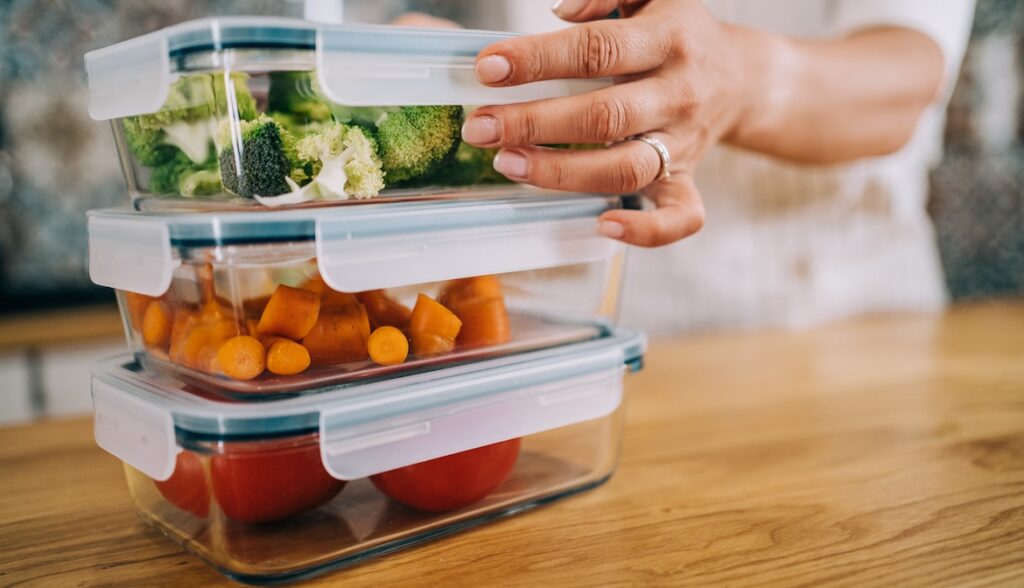There’s no denying that there’s a huge plastic problem happening right now that’s contributing to the global climate crisis. There’s a lot you can do at home to reduce your reliance on plastic. If you’re looking for new food storage containers, your best bet is to invest in glass containers instead of plastic ones.
Choosing glass food storage containers over plastic ones is an easy way to cut down on your plastic consumption—and even better, it might be a healthier choice (not to mention helping you meet your fridge shelf-filling goals and motivating you to finish all those leftovers).
Below, food safety expert Trevor Craig, Corporate Director of Technical Training and Consulting at Microbac Laboratories, explains when and why storing food in glass containers is ideal, plus best practices and advice on using plastic containers when it’s unavoidable or a more practical solution for your budget and food storage needs — all without putting your health at risk.
3 Reasons Glass Containers Are the Best Way to Store (Most) Food
1. Glass is safe in high and low temperatures
Craig explains that glass is generally safer over a wide range of temperatures. Unlike plastic, glass “retains its shape as it gets hotter and colder, avoiding breakage that could leach harmful chemicals,” he says. For these reasons, glass containers are ideal for freezer-safe long-term food storage. Glass can also withstand the scorching heat of a dishwasher, which leads to the next benefit:
Related article
2. Glass is more hygienic
Did you know it’s impossible to remove the smell of marinara sauce from a plastic container? That’s because plastic is porous. “Glass is easier to clean because it’s not porous, which means not only is there less dirt, but there are also fewer places for hard-to-clean food and bacteria to get in,” explains Craig.
Plastic, by contrast, is an obstacle when it comes to cleanliness. As Kate Reeder, MCN, RDN, LDN, previously told Well+Good, plastic food storage containers can literally become a breeding ground for bacteria. “Plastic is a porous material, it has tiny holes that allow particles to pass through and be absorbed,” she warned. Trevor adds that plastic also picks up odors, which are not exactly pleasant to say the least.
3. Glass has a long lifespan
Glass food storage containers tend to be more expensive than their plastic counterparts, but when you consider food quality, health, and cost of use, they’re generally a better investment. “Glass lasts longer and can be reused or recycled,” says Craig. “That’s not necessarily the case with plastic, which can lose shape, crack or peel, and need to be disposed of more frequently.” Of course, you’ll need to treat glass with care to avoid breaking it. But if you can do that, you can expect to get the most out of your investment in the long run compared to the alternatives. At the same time, you’ll be doing your part to avoid adding (future) plastic waste to the ecosystem.
FYI and Safety Tips for Plastic Food Storage Containers
Glass food storage containers have some obvious advantages, but they can’t (and may not) be used for all food storage. “While glass is generally safe, it’s not suitable for everyone or every situation,” says Craig. “Glass is often expensive, not child-safe, and can break. It’s also heavy and not suitable for on-the-go use, like camping, carrying babies and kids, or everyday lunches.”
If it’s more practical to store or transport your food in plastic containers, listen to Craig and make sure you’re using the best type of plastic. “PET or PETE (polyethylene terephthalate), HDPE or LDPE (low-density and high-density polyethylene), and PP (polypropylene) are all food-safe,” he says. “Typically, this information will be on the bottom of the container or on the packaging.” Additionally, he highly recommends using plastic products that are clearly labeled as BPA-free. (BPA, the chemical used to harden plastics and line food cans, is an endocrine disruptor linked to a variety of health problems, including premature puberty, breast cancer, and cardiac and metabolic problems.)
Additionally, Craig warns that not all plastic is designed to be reused. This includes many of the plastic containers for takeout and food delivery. These are usually designed for one-time use and aren’t as sturdy as the plastic containers you buy to last longer. (This also applies to disposable plastic water bottles, whose materials, as Craig previously explained, “can break down and leach dangerous chemicals” if reused.) “Many are not microwave, dishwasher or freezer safe, and none are oven safe,” he explains. “Overall, think of food containers as specialized plastics designed for short-term storage (days or weeks), not disposable plastics. [items] Things like plastic wrap, tableware, bottles, etc.”
Finally, he recommends tossing plastic products as soon as they become damaged, warped, discolored or smelly. “When you do throw them out, check your local recycling laws to see if they can be recycled, as many types of plastic cannot be recycled,” he adds. (Glass, on the other hand, can be recycled indefinitely, another benefit of this food storage method.)


